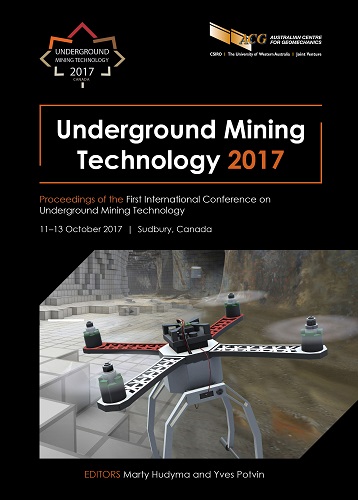Statistical analysis of the outlier events from seismic stress inversion

|
Authors: Abolfazlzadeh, Y; Penhall, SL; McKinnon, SD |
DOI https://doi.org/10.36487/ACG_rep/1710_21_Abolfazlzadeh
Cite As:
Abolfazlzadeh, Y, Penhall, SL & McKinnon, SD 2017, 'Statistical analysis of the outlier events from seismic stress inversion', in M Hudyma & Y Potvin (eds), UMT 2017: Proceedings of the First International Conference on Underground Mining Technology, Australian Centre for Geomechanics, Perth, pp. 269-277, https://doi.org/10.36487/ACG_rep/1710_21_Abolfazlzadeh
Abstract:
The seismic stress inversion method has been developed and used in the field of crustal seismology, but due to the technical challenges and lack of a mining-specific application methodology, it has rarely been used for the analysis of mining-induced seismicity. The technique is based on assumptions that the stress is uniform in the volume of study (less satisfied in mining environments and near geological structures), and slip on any fault plane occurs in the direction of maximum resolved shear stress. Currently, there is a variety of seismic stress inversion algorithms available which use multiple seismic events to constrain the fault plane solutions for determining the four parameters of the stress tensor (orientations of principal stresses and their relative magnitude). First motion stress inversion (MOTSI) is a widely used code that uses first motion data in the inversion. For a group of events, MOTSI runs a test on two factors; dS and dM. The parameter dS specifies rejection of the homogeneous stress hypothesis when it exceeds 2.32 (95% confidence level) and the parameter dM defines the similarity between the stress-constrained and unconstrained focal mechanisms (dM = 1, represents no change). Events with large deviations from acceptable levels of dS and dM should not be used in the stress inversion process. These events are expressed as outliers because there is not enough information to infer their relation to the other events. The goal of this paper is to use statistical techniques to explore the characteristics of these outlier events. Outliers are of particular interest in this case because by indicating non-compliance with the homogeneous stress hypothesis, they may be good indicators of zones where there is strong influence of geological structures on the stress field. The seismic events for this study are recorded over a period of ten months during the early stages of mining (to satisfy the uniform stress assumption) and from a specific area (to have a better coverage of focal sphere) of the Nickel Rim South Mine in Sudbury, Canada. More than 500 seismic events were manually processed and after removing noise and applying different filters, we were able to determine the orientation of the principal stresses through seismic stress inversion from the middle level of the mine. The aggregate of the inversions inferred a north–south, northeast–southwest orientation of the maximum principal stress and near vertical minimum principal stress. In each inversion processed, several events were tagged as outliers according to the mentioned criteria. Several statistical analyses including mean, standard deviation, variance, t-test, box plot, Kurskal–Walles test, and principal component analysis (PCA) were conducted over 10 seismic source parameters (i.e. source radius, seismic moment, etc.) to determine the relation between outliers and used data.
Keywords: microseismic monitoring, seismicity, stress mapping, seismic stress inversion, statistical analysis
References:
Abers, GA & Gephart, JW 2001, ‘Direct inversion of earthquake first motions for both the stress tensor and focal mechanisms and application to southern California’, Journal of Geophysical Research, vol. 106, no. 26, pp. 523–526.
in J Wesseloo (ed.), Proceedings of the Eighth International Conference on Deep and High Stress Mining, Australian Centre for Geomechanics, Perth, pp. 247–257.
in M Hudyma & Y Potvin (eds), Proceedings of the Seventh International Seminar on Deep and High Stress Mining, Australian Centre for Geomechanics, Perth, pp. 189–208.
Turichshev, A & Brummer, RK 2008, In-Situ Rock Stress Measurements at the 1480 Level of the Nickel Rim South Project, Itasca Consulting Canada Inc., Xstrata Nickel, Nickel Rim South Project.
© Copyright 2026, Australian Centre for Geomechanics (ACG), The University of Western Australia. All rights reserved.
View copyright/legal information
Please direct any queries or error reports to repository-acg@uwa.edu.au
View copyright/legal information
Please direct any queries or error reports to repository-acg@uwa.edu.au